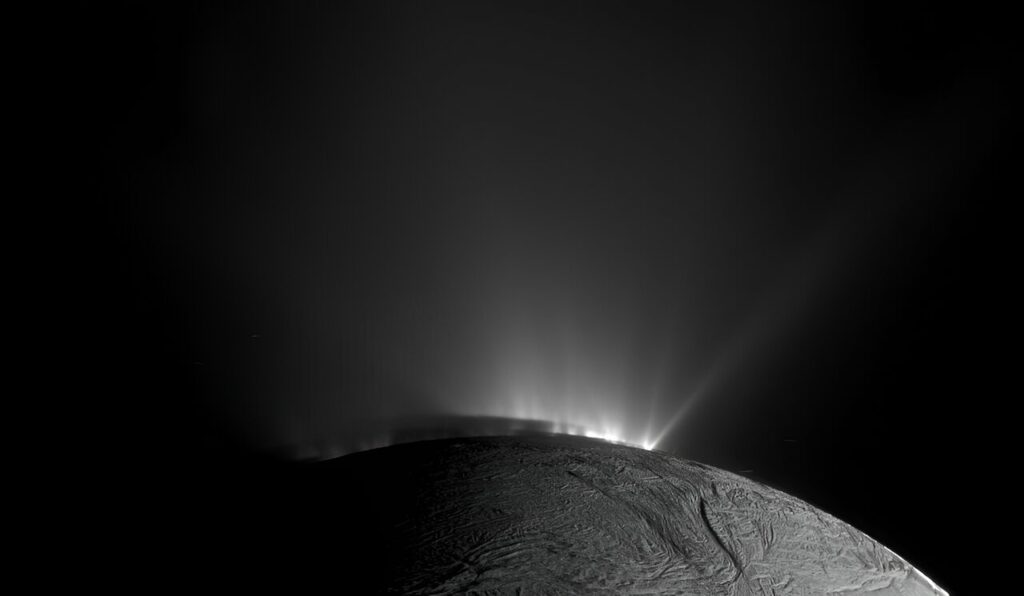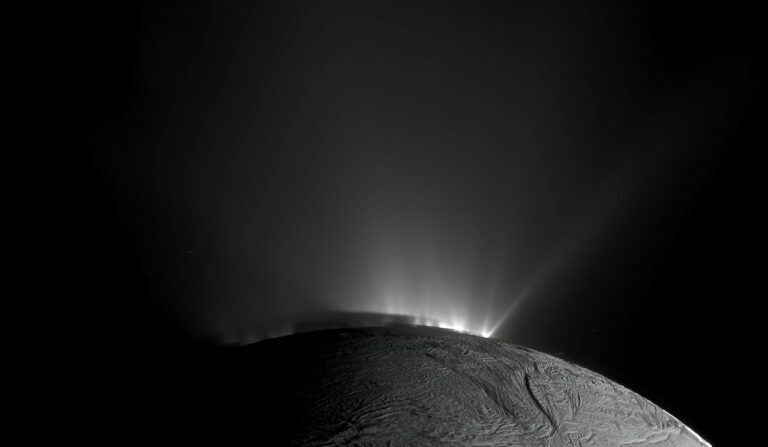NASA Research Discovers Life-Energizing Energy Source and Molecule on Enceladus
A focused analysis of data collected by NASA’s Cassini spacecraft at Saturn’s icy moon reveals evidence of a vital component for life and a highly potent energy source to support it. While scientists were already aware that the substantial plume of ice grains and water vapor emanating from Enceladus contained organic compounds crucial for life, a recent examination of Cassini’s data has strengthened the case for habitability. The study has confirmed the presence of hydrogen cyanide, a molecule pivotal to the origins of life.
Furthermore, the researchers discovered indications of a robust chemical energy source within the ocean beneath Enceladus’s icy surface, responsible for feeding the plume. Previously unidentified, this energy source comprises various organic compounds, some of which, on Earth, serve as fuel for organisms. Published in Nature Astronomy, these findings suggest that Enceladus may possess more chemical energy than previously estimated. The increased availability of energy enhances the likelihood of life potentially thriving and persisting in this diminutive moon.
Lead author Jonah Peter, a doctoral student at Harvard University who conducted much of the research at NASA’s Jet Propulsion Laboratory in Southern California, stated, “Our work provides further evidence that Enceladus is host to some of the most important molecules for both creating the building blocks of life and for sustaining that life through metabolic reactions. Not only does Enceladus seem to meet the basic requirements for habitability, we now have an idea about how complex biomolecules could form there, and what sort of chemical pathways might be involved.”

Versatile and energetic
“The identification of hydrogen cyanide was particularly thrilling because it serves as the foundational element for most hypotheses regarding the origin of life,” remarked Peter. Life, as we comprehend it, necessitates fundamental building blocks like amino acids, and hydrogen cyanide stands out as one of the most crucial and versatile molecules essential for amino acid formation. Given its ability to arrange molecules in various configurations, the researchers describe hydrogen cyanide as the Swiss army knife of amino acid precursors. “
As we sought to challenge our findings by exploring alternative models,” Peter further explained, “the evidence grew stronger. Ultimately, it became evident that incorporating hydrogen cyanide is essential to align the plume’s composition with our observations.”

In 2017, researchers uncovered evidence at Enceladus pointing to chemistry that could potentially support life within its ocean, if it exists. The presence of carbon dioxide, methane, and hydrogen in the plume hinted at methanogenesis, a metabolic process responsible for methane production. Methanogenesis is widespread on Earth and is thought to have played a crucial role in the origin of life on our planet. The recent study reveals evidence of energy sources beyond the production of methane, indicating a more potent and diverse array of chemical pathways. The researchers identified various oxidized organic compounds, suggesting numerous routes for potentially sustaining life in Enceladus’ subsurface ocean. Oxidation is significant as it facilitates the release of chemical energy.
“If methanogenesis is likened to a small watch battery in terms of energy, then our findings suggest that Enceladus’ ocean may resemble more of a car battery, capable of providing a substantial amount of energy for any potential life,” explained Kevin Hand, a co-author of the study and principal investigator of the effort leading to these new results at NASA’s Jet Propulsion Laboratory (JPL).
Math is the way
In contrast to earlier research that relied on laboratory experiments and geochemical modeling to simulate Enceladus conditions observed by Cassini, the authors of the new study employed comprehensive statistical analyses. They scrutinized data obtained by Cassini’s ion and neutral mass spectrometer, which investigated gas, ions, and ice grains around Saturn. By quantifying the information within the data, the authors discerned subtle distinctions in how effectively various chemical compounds accounted for the Cassini signal. “There are numerous potential puzzle pieces that can be assembled to match the observed data,” explained Peter.
“We used mathematical and statistical modeling to identify the combination of puzzle pieces that best aligns with the plume composition, making optimal use of the data without overinterpreting the limited dataset.” While scientists are still far from determining whether life could originate on Enceladus, Peter emphasized that the new study lays out chemical pathways for life that can be experimentally tested. Meanwhile, Cassini continues to provide valuable insights long after revealing Enceladus as an active moon.
The mission concluded in 2017 by intentionally plunging the spacecraft into Saturn’s atmosphere. “Our study illustrates that, even though Cassini’s mission has concluded, its observations continue to yield new insights about Saturn and its moons, including the enigmatic Enceladus,” noted Tom Nordheim, a co-author of the study and a planetary scientist at NASA’s Jet Propulsion Laboratory (JPL), who was part of the Cassini team.
This article is republished from PhysORG under a Creative Commons license. Read the original article.
Do not forget to share your opinion with us to provide you with the best posts !





0 Comments